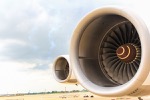
The deadly Southwest engine failure in April has prompted action by the Federal Aviation Administration (FAA). The FAA is now requiring inspections of General Electric’s CFM56-7B engines in a new air-worthiness directive. The ultrasonic inspections ordered by the agency are necessary because regulators fear that damage to the metal may not be readily apparent upon visual examination. The inspections are to be performed within 20 days of the order on all fan blades with more than 30,000 cycles.
Before the FAA announced its order, CFM International, the manufacturer of these engines, provided guidelines for ultrasonic inspections. CFM suggested an even more aggressive approach than the order issued by the FAA. The company advised that fan blades with 20,000 cycles should be inspected by the end of August. It additionally recommended that all fan blades undergo periodic inspections when they reach 20,000 cycles and thereafter every 3,000 cycles- or the equivalent of two years in use. Approximately 14,000 engines in use are subject to the new inspection directive. While airlines are not obligated to follow the company’s guidelines, they are legally required to follow orders issued by the FAA.
In publishing its directive, the FAA expressed concern that other engines like the one on the Southwest flight could have similar problems. It stated that it was likely that comparable designs may contain similar unsafe conditions. The directive circumvented the typical formal process for implementing orders as there was no opportunity for notice and public comments. The FAA insists that such action was necessary given the imminent and real danger posed by these engines to passengers.
The National Transportation Safety Board (NTSB) issued a report indicating that metal fatigue was the cause of engine failure in two of Southwest Airline’s recent episodes. In both incidents, the report confirmed that fan blades in the engines tore apart and hurled shrapnel into the plane. In the most recent incident in April, this led to the death of one passenger. Southwest Airlines maintains that its current maintenance program already conforms to the inspection requirements contained in the FAA order.
If you or a member of your family suffered injury or death as a result of negligence or a defective automobile, contact the attorneys Alexander Law Group, LLP. Our exceptional personal injury lawyers will answer your questions and get you the maximum compensation that is possible. Call 888.777.1776 or contact us online.

